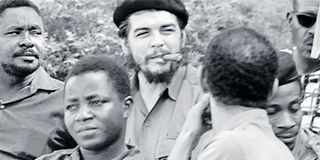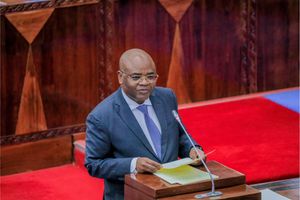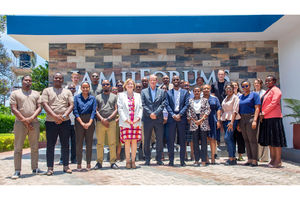Inside Che Guevara’s secret visit to Tanzania-2

Che Guevara (centre) stayed in Tanzania from February 11 to 18, 1965. He gave a press conference in Dar es Salaam on February 18th before he left the country. PHOTO I FILE
What you need to know:
- The longer they stayed in Dar es Salaam, the greater the chances they would be detected by enemies. The Tanzanian government was not informed of his presence at the time. Exactly when the Tanzanian government was informed of Che’s presence is not clear.
It is not clear if Che Guevara was included in that short tour of Dar es Salaam. He had already seen most of the city in his visit two months before.
Che gave his men new names based on Swahili numbers. He gave Dreke the name Moja (one), Tamayo became Mbili (two), and he named himself Tatu (three). The wait in Dar es Salaam was short; but Che was restless nevertheless. He was anxious to go to the Congo.
The longer they stayed in Dar es Salaam, the greater the chances they would be detected by enemies. The Tanzanian government was not informed of his presence at the time. Exactly when the Tanzanian government was informed of Che’s presence is not clear.
Che spent at least one day in Dar es Salaam by most accounts. He left on April 20 with a group of about 14 people. Tchamlesso and a member of the Tanzanian police accompanied the Cubans. The Tanzanian police joined them to make sure that they did not have any problems along the way. The men travelled in a convoy of three cars: one Land Rover, three Mercedes Benzes, and two jeeps.
The vehicles carried some of the weapons they would use in the Congo. The Cubans, including Che, took turns driving the more than 1,700 Kilometers from Dar es Salaam to Kigoma. It was a long journey on dirt road that took two days. The group was delayed at one point because they had to wait for a barge to cross a river. Che read a book about the Congo when he was not driving.
The group arrived in Kigoma on the night of April 22, 1965. Kigoma was a city of about 70,000 people at the time. Congo was about 50 Kilometers directly across Lake Tanganyika, one of the deepest lakes in the world. Kigoma was a busy city. Refugees were escaping the Congo and rebel soldiers came in and out of the city in large numbers. The Cubans split up into two groups. Che, Dreke, Tamayo, Zerquera, and a couple of other Cubans went to stay at the residence of Sinfua, the Regional Commissioner of Kigoma.
Che and his men spent one night in Kigoma. The Tanzanian Regional Commissioner of Kigoma, Sinfua, warned Che during their discussions that the Congo rebels were undisciplined. Che would admit later that Sinfua had been correct. The Cubans boarded a boat just before midnight on April 23, 1965 for the Congo. Che and his men would spend the next 7 months fighting in the Congo.
Tanzania was critical for the Cuban operations in the Congo. Che could not have lasted seven months in the Congo without cooperation of the Tanzanian government. The heart of the Congo operations was at the Cuban Embassy in Dar es Salaam. All supplies came through Tanzania had to be sent to the Congo.
Che’s whereabouts was unknown to the public. Very few people were aware of Che’s presence in Tanzania and in the Congo. According to most accounts, Westerners did not know Che’s whereabouts.
Larry Devlin, the CIA chief station in the Congo, claimed that he reported Che’s presence in October of 1965, but was ignored. Some recent reports indicate that the Americans had a ship in the Indian Ocean along East Africa monitoring communication between the Cuban Embassy in Dar es Salaam and the Cuban soldiers in the Congo.
Interception of the communication does not necessary mean that Americans knew Che was among the soldiers, even if they had their suspicions. There is one report that indicates the possibility that someone may have known where Che was at the time.
Rumors emerged in Cairo and Dar es Salaam in October of 1965 that Che and Soumialot were killed in the Congo. The reports forced Soumialot to give a press conference in Dar es Salaam in October 17, 1965. The Times of London reported Soumialot’s press conference that same day, October 17, 1965. Soumialot told reporters that he was well and alive. He denied claims that Che had been in the Congo and that he was killed in an ambush.
The situation in the Congo was desperate for the Cubans by the end of October 1965. A group of white mercenaries and Congo soldiers led by Mobuto Sese Seko and an Irish mercenary named Mike Hoare, started closing in on the Cubans by October.
To make matters worse, the Congo leader Joseph Kasa-Vubu went to the OAU conference in Ghana from October 21 to 15, 1965, and promised to remove foreign mercenaries. He managed to secure OAU resolution calling for the withdrawal of all foreign troops from Congo. Nyerere called Ambassador Rivalta shortly afterwards and asked the Cubans to withdraw their troops.
Che and the Cuban soldiers crossed Lake Tanganyika and entered Kigoma on November 21, 1965. Oliva and another Cuban diplomat named Coloman Ferrer, were in Kigoma to welcome Che and the Cuban soldiers back to Tanzanian soil. The Tanzanian police went to the boat and took all the weapons. Che took a bath, changed clothes, and ate food.
He and his men slept on the floor of a waiting room in Kigoma. This was the third and last time Che would enter Tanzania; it was a bittersweet moment for Che. The mission had failed, but his determination to continue the struggle remained strong.
Coloman received instructions to take Che and a few men he selected back to Dar es Salaam. The group left on a van for Dar es Salaam. They barely made it on time for the last ferry that crossed the river at 7pm. Coloman was instructed to keep the Cuban embassy informed of their whereabouts. He made a call from Morogoro to inform the embassy of their location. Coloman and Che went to the house owned by the Tanzania Director of Prisons, near the airport when they reached Dar es Salaam. Che and other comrades spent the first night at the house. Coloman went to see Che the next day and bought some supplies for him. Che would spend another two or three days at the house near the airport, just outside the city.
So it was, Che was in Dar es Salaam once again in the end of November 1965. Eventually he moved from the house on the outskirts of Dar es Salaam to a two- bedroom apartment on top of the Cuban Embassy in Upanga, a suburb of Dar es Salaam. He would spend the next four months in the apartment without venturing outside.
Che kept himself very busy in Dar es Salaam. He contemplated about the shortcomings of the Congo operation and considered his next move. Che was clear about one thing: he wanted to fight. However, he was not sure where he would launch his next campaign against imperialists. He did not want to return to Cuba. The failure of the Congo mission weighed heavily on him.
The Cubans kept Che’s presence in Tanzania top secret. Very few people in the Cuban Embassy knew of his presence. There were only about three people who were allowed to enter Che’s apartment: Rivalta, Oscar Fernandez Mell, Padilla, and Delfin, the telegraph operator. Che spent his time reading, playing chess, and writing diaries of his Congo experiences.
Spending four months in an apartment without going outside would be difficult for most people. This was not the case for Che. The few Cubans who interacted with Che during that time did not notice any signs of distress. He welcomed the new year of 1966 in Dar es Salaam with Rivalta, Padillla, and Fernandez Mell. Che spent time. He spent considerable time working on his Congo diaries. He dictated the text to Ferrer and Ferrer would later transcribe it. Che revised and corrected the final manuscript.
One of the best moments for Che in Tanzania was when his wife Aleida March came to visit him secretly sometime around February of 1966. Aleida and Che would spend the next month, clammed up in the two-bedroom apartment. According to Aleida, this was to become one of the best times the couple spent together. They spent day and nights together catching up on lost time. The couple had not spent much time together since they got married in 1959. And so it was in Dar es Salaam that Che would rekindle romance with his wife. Aleida recalled later that “it was the first time we had ever been alone together” and closest thing to a “honeymoon” that the two had enjoyed. She would allude to “making up of all the lost time.” The reunion would be the first and last time the two spent considerable time alone.
Professor Azaria Mbughuni is based at Lane College, US. H e can be contacted through email: [email protected], or Twitter: @zariaTZ




